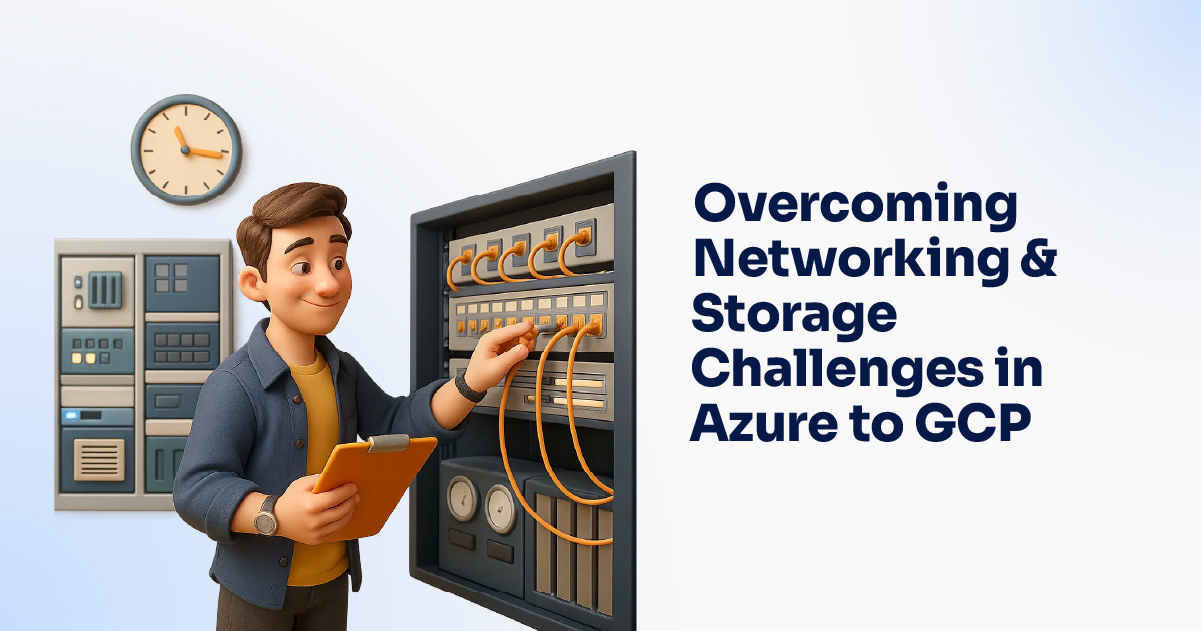
Migrating from Microsoft Azure to Google Cloud Platform (GCP) offers businesses the opportunity to tap into Google’s advanced data analytics, machine learning capabilities, and flexible pricing models. However, the journey isn’t without its challenges—especially when it comes to networking and storage. These two components are the backbone of any cloud environment, and mishandling them during migration can lead to disruptions, data loss, and increased operational costs.
In this blog, we’ll explore the key networking and storage challenges encountered during Azure to Google Cloud migration and offer practical solutions to overcome them.
Understanding the Complexity of Cloud-to-Cloud Migrations
Moving workloads between cloud providers is inherently complex. Azure and GCP, while both powerful platforms, have different architectures, terminologies, APIs, and services. Therefore, a lift-and-shift approach without due diligence may lead to significant compatibility and performance issues.
Networking Challenges in Azure to Google Cloud Migration
1. IP Address Reallocation and Reconfiguration
In Azure, virtual machines and services typically use internal and public IPs that are managed differently than in GCP. When you move your workloads, you cannot carry over Azure-specific IP addresses directly into GCP. This requires:
- Reassigning IP addresses
- Updating DNS records
- Reconfiguring firewall rules
Solution: Create a network mapping plan before migration. Use GCP’s VPC (Virtual Private Cloud) to set up custom subnets and IP ranges that closely mirror your Azure environment. Automate DNS updates to minimize downtime.
2. Latency and Bandwidth Bottlenecks
Transferring large volumes of data over the public internet can lead to high latency and potential timeouts.
Solution: Leverage Google Cloud Interconnect or Transfer Appliance for secure and high-throughput data migration. These options offer direct connectivity between your on-premises or Azure resources and GCP, reducing latency and improving reliability.
3. Security and Firewall Configurations
Azure uses Network Security Groups (NSGs), while GCP uses firewall rules defined within VPCs. The two have different syntax, protocols, and configurations.
Solution: Conduct a thorough audit of your existing NSGs in Azure. Map these to equivalent firewall rules in GCP. Tools like Terraform or Anthos can help automate this translation, ensuring consistent security policies across environments.
Storage Challenges in Azure to Google Cloud Migration
1. Different Storage Architectures
Azure offers services like Blob Storage, Managed Disks, and Azure Files, while GCP provides alternatives such as Cloud Storage (object), Persistent Disks (block), and Filestore (file). Mapping one-to-one equivalents isn’t always straightforward.
Solution: Categorize your data by storage type and usage pattern (hot, cold, archive). Use the appropriate GCP storage class (Standard, Nearline, Coldline, Archive) to match the performance and cost characteristics of your existing Azure storage.
2. Data Integrity and Consistency
Ensuring data consistency during migration is critical, especially for applications requiring transactional integrity like databases and CRM systems.
Solution: Use data replication tools such as Velostrata, CloudEndure, or Migrate for Compute Engine to ensure data integrity. Implement checksum verification and perform validation post-migration.
3. Access Control and IAM Mismatch
Azure and GCP have different Identity and Access Management (IAM) models. Azure uses Role-Based Access Control (RBAC) tightly coupled with Azure AD, while GCP has its own IAM structure.
Solution: Before migrating, audit all storage-related access policies in Azure. Then replicate equivalent IAM roles in GCP. Consider implementing least privilege principles and use GCP’s resource hierarchy (Organization > Folders > Projects) for fine-grained access control.
Best Practices to Ensure a Smooth Migration
1. Conduct a Comprehensive Assessment
Start with a full inventory of your current Azure environment, focusing on networking topologies, firewall rules, storage usage, and performance metrics.
2. Use Cloud-Native Migration Tools
Google Cloud offers native tools such as Migrate for Compute Engine and Transfer Service for Cloud Storage. These tools simplify the process, automate configurations, and minimize manual errors.
3. Plan for Downtime and Rollback
Even with meticulous planning, unforeseen issues may arise. Build in buffer time, set expectations with stakeholders, and create rollback strategies in case of critical failures.
4. Test Extensively
Run a proof of concept (PoC) to test the migration of non-critical workloads. Use this to validate configurations, test network performance, and fine-tune security policies.
Partnering with Cloud Migration Experts
Navigating the complexities of cross-cloud migration is no small feat. That’s why partnering with experienced professionals who offer Cloud Migration Services is a smart move. These experts can guide you through planning, executing, and validating every step of your Azure to Google Cloud migration, ensuring minimal risk and maximum performance.
Conclusion
Migrating from Azure to Google Cloud is a strategic decision that can unlock new capabilities for your business. However, success lies in proactively addressing networking and storage challenges. By understanding the differences between the two platforms and adopting best practices, you can ensure a seamless transition.
For a tailored migration plan and expert guidance, explore Cloud Migration Services from Exinent. Let us help you modernize your infrastructure with confidence and clarity.
